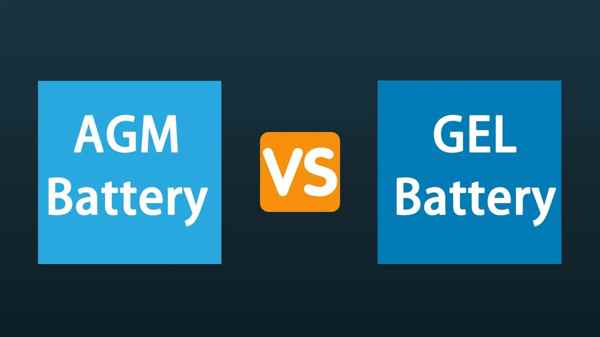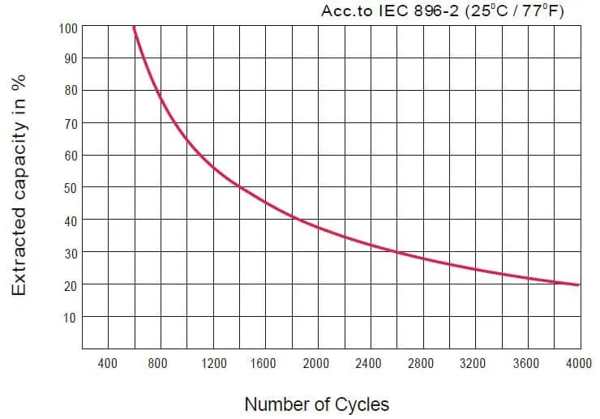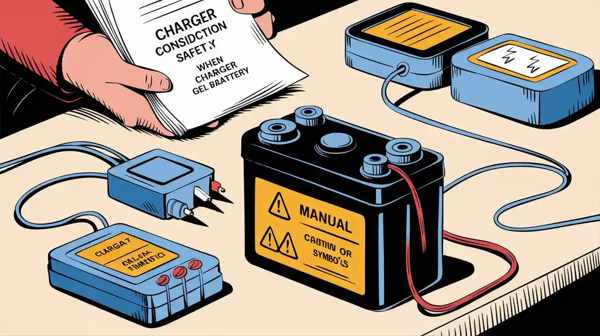O que é melhor, uma bateria AGM ou gel?
Quando você procura um confiável, bateria livre de manutenção para o seu sistema solar, barco, ou poder de backup, você encontrará rapidamente duas opções populares: AGM e Gel. Ambos são tipos de baterias seladas de chumbo-ácido, mas eles usam tecnologias diferentes internamente, o que os torna mais adequados para diferentes trabalhos. Então, qual é realmente melhor?
Nem AGM nem Gel são universalmente "melhores"; a melhor escolha depende da sua aplicação específica. Resumidamente, AGM (Tapete de vidro absorvente) as baterias geralmente são melhores para aplicações que exigem alta potência (como ligar um motor) e carregamento mais rápido. As baterias de gel geralmente se destacam em, aplicações de descarga profunda e podem ser mais tolerantes a temperaturas ambientes muito altas.

No GYCX Solar, trabalhamos com uma ampla gama de tecnologias de baterias, e a nossa experiência reside em combinar a bateria certa com o trabalho certo. Vamos analisar as diferenças entre AGM e Gel para ajudá-lo a tomar uma decisão informada.
As baterias AGM são de chumbo-ácido ou gel??
Com todas as siglas, é fácil ficar confuso. As tecnologias AGM e Gel são concorrentes?, ou eles estão relacionados? Vamos esclarecer a árvore genealógica da bateria.
As baterias AGM são um tipo de chumbo-ácido bateria, mas eles são não Baterias em gel. Pense em "chumbo-ácido" como nome de família principal. Sob aquela família, você tem dois ramos principais: tradicional "Inundado" baterias (que precisam de manutenção) e "Ácido-chumbo selado" ou baterias VRLA (que são isentos de manutenção). Tanto AGM quanto Gel são dois tipos diferentes de baterias VRLA seladas. A principal diferença entre eles é como eles imobilizam o eletrólito ácido dentro.

Mergulhe mais fundo: Um guia rápido para a terminologia
- Bateria de chumbo-ácido: A categoria geral de bateria que utiliza placas de chumbo e um eletrólito de ácido sulfúrico.
- Inundado de chumbo-ácido (Fla): O tradicional, "célula úmida" tipo. As placas de chumbo estão submersas em ácido líquido, e requer reabastecimento regular com água destilada.
- Chumbo-ácido selado (VRLA – Chumbo-ácido regulado por válvula): A categoria livre de manutenção. A bateria está selada, e gases internos são recombinados.
- AGM (Tapete de vidro absorvente): O ácido é absorvido e mantido no lugar por finas esteiras de fibra de vidro imprensadas entre as placas de chumbo..
- Gel: O ácido é misturado com sílica ativa para criar uma camada espessa, gel viscoso que não flui.
Então, enquanto ambos são selados e livres de manutenção, o método que usam para conter o ácido lhes confere características de desempenho diferentes.
Como saber se a bateria é AGM ou gel?
Você tem uma bateria de chumbo-ácido selada, mas você não tem certeza se é um AGM ou um Gel. Saber a diferença é fundamental porque eles exigem perfis de carregamento diferentes. Como você pode identificar qual tipo você tem?
A maneira mais confiável de saber se uma bateria é AGM ou Gel é leia a etiqueta na caixa da bateria. A maioria dos fabricantes imprimirá claramente "AGM," "Tapete de vidro absorvente," "Gel," ou "Célula de Gel" no adesivo. Se a etiqueta estiver gasta ou pouco clara, seu próximo melhor passo é procure o número do modelo online no site do fabricante. A aplicação pretendida do produto também pode ser uma pista.

Mergulhe mais fundo: Sua lista de verificação de identificação
Aqui estão as etapas para identificar o tipo de bateria:
- Leia o rótulo com atenção: Este é o método mais direto. Procure o nome da tecnologia. Às vezes pode apenas dizer "VRLA" ou "Ácido-chumbo selado," nesse caso, você pode precisar se aprofundar.
- Pesquise o número do modelo: Cada bateria tem um número de modelo (Por exemplo, "8A31DT" ou "GPL-31T"). Uma rápida pesquisa na Internet por esse número de modelo quase sempre levará você a uma página de produto ou ficha técnica que especifica a química.
- Considere o aplicativo original:
- Baterias AGM são excelentes para fornecer alta corrente, por isso são muito comuns em veículos de alto desempenho com tecnologia start-stop, carros com sistemas de áudio potentes, e para partida de motor marítimo ou RV.
- Baterias em gel excel em lento, estável, descargas profundas. Eles são frequentemente encontrados em scooters elétricos de mobilidade, cadeiras de rodas motorizadas, e algumas aplicações solares de telecomunicações ou fora da rede.
- Por que é fundamental saber: Você deve saber o tipo para selecionar o perfil de carregamento correto em seu carregador inteligente ou controlador de carregamento solar. Usando uma configuração AGM em uma bateria Gel (ou vice-versa) pode levar a subcarga ou sobrecarga, ambos reduzirão a vida útil da bateria.
Qual é a vida útil de uma bateria de gel?
Quando você investe em um Bateria de gel1, você quer saber quantos anos de serviço2 você pode esperar. Com cuidado adequado e as condições certas, eles podem ter um desempenho durável, mas a vida deles é finita.
Uma bateria de gel de ciclo profundo de qualidade normalmente tem um vida do calendário de 5 para 10 anos. Em termos de uso, pode entregar em qualquer lugar de 500 para superar 1,000 Ciclos de descarga de carga. Esta vida útil não é garantida e é altamente dependente de vários fatores críticos, mais notavelmente carregamento correto, temperatura operacional, e quão profundamente é descarregado regularmente.

Mergulhe mais fundo: Fatores que determinam a longevidade
A vida útil real que você obtém da sua bateria de gel será determinada por estas variáveis-chave:
- Método de carregamento: Como discutiremos a seguir, usar o perfil de carga correto específico do gel é o fator mais importante. A sobrecarga consistente ou submarca diminuirá drasticamente a vida útil da bateria.
- Temperatura de operação: O calor é o inimigo de todas as baterias de chumbo-ácido. A temperatura ideal de operação é em torno de 25°C (77°F). Num clima consistentemente quente como o de Bangkok, uma bateria mantida em um espaço mal ventilado pode ter sua vida útil reduzida pela metade.
- Profundidade de Descarga (Departamento de Defesa): Isso se refere a quanto da capacidade da bateria você usa em cada ciclo. Uma bateria que só é descarregada para 30% de sua capacidade durará por muito mais ciclos do que um que é constantemente descarregado para 80%.
- Como ele se compara:
- vs.. AGM: A vida útil das baterias AGM e Gel é frequentemente comparável quando ambas são bem tratadas, embora o Gel às vezes possa oferecer uma ligeira vantagem no ciclo de vida para, descargas profundas, sendo menos tolerante com cobranças indevidas.
- vs.. Lítio (LFP): A diferença é significativa. Uma bateria LFP moderna, qual solar GYCX geralmente recomenda para solar, oferece uma vida muito mais longa (10-20 anos e 3,000-6,000+ ciclos), tornando-o um investimento superior a longo prazo para aplicações diárias de ciclismo.
Uma bateria de gel precisa de um carregador especial?
Você escolheu uma bateria de gel para seu benefícios sem manutenção3. Você pode usar qualquer carregador de bateria padrão para mantê-la carregada? Este é um ponto crítico onde um erro pode custar muito caro.
Sim, absolutamente. As baterias de gel requerem um carregador inteligente compatível que tenha um "GEL" Perfil de carregamento. Usar um carregador padrão projetado para carros tradicionais inundados ou baterias de ciclo profundo quase certamente danificará ou destruirá uma bateria de gel com o tempo. A tensão de carregamento e o algoritmo devem corresponder precisamente à química do gel para garantir sua saúde e longevidade.

Mergulhe mais fundo: Por que o carregador certo é não negociável
Veja por que um carregador compatível com gel é essencial:
- Impede a tensão excessiva: As baterias de gel são muito sensíveis à alta tensão. Um perfil de gel adequado utiliza pontos de ajuste de tensão mais baixos (normalmente chegando em torno de 14,1V - 14,4V). Um carregador de bateria inundado padrão pode aumentar a tensão para 14,8 V ou superior, que vai "cozinhar" o gel.
- Evita a equalização destrutiva: Muitos carregadores de baterias inundadas têm uma "equalização" modo, que é uma sobrecarga controlada projetada para equilibrar as células. Este processo é altamente destrutivo para uma bateria de gel. Isso faz com que a água no eletrólito em gel se decomponha em gás que é expelido da bateria. Já que você não pode adicionar água de volta, Isso seca permanentemente o gel, arruinando sua capacidade.
- Carregamento em vários estágios: Um carregador inteligente com um perfil de gel usa um algoritmo de vários estágios (Por exemplo, volume, absorção, flutuador) isso é precisamente adaptado ao que uma bateria de gel precisa. Ele carrega com eficiência e depois cai para um nível de "flutuação" seguro" tensão para manter a bateria sem sobrecarregá-la.
- AGM também é diferente: É importante observar que as baterias AGM também possuem seu próprio perfil de carregamento específico., que é diferente de Gel e Flooded. Um bom carregador multiquímico terá configurações separadas para cada.
História solar Gycx: “Sempre dizemos aos nossos clientes que o carregador é tão importante quanto a própria bateria. Quando projetamos um sistema, seja energia solar ou de reserva, garantimos que o controlador de carregamento solar ou carregador CA esteja perfeitamente programado para a tecnologia de bateria usada. Isto protege o investimento do cliente e é uma parte fundamental da nossa vantagem profissional."
Então, o que é melhor, AGM ou Gel? É uma troca. AGM é fantástico, burro de carga versátil, ótimo para uso de alta potência e ciclo profundo. Gel é um executor especializado de ciclo profundo que pode ser mais durável em climas muito quentes, mas requer carregamento mais preciso. Para muitas aplicações solares modernas, a conversa agora inclui lítio LFP, que oferece vida útil e desempenho superiores.
No Gicx Solar, temos a experiência para ajudá-lo a navegar nessas escolhas. Podemos analisar suas necessidades para recomendar a tecnologia da bateria – seja ela AGM, Gel, ou Lítio – que fornecerá o melhor valor e desempenho para sua aplicação específica. Entre em contato conosco hoje para uma consulta profissional!
Compreender a vida útil das baterias de gel pode ajudá-lo a tomar decisões de investimento informadas. ↩
A exploração deste tópico fornecerá insights sobre a longevidade e a confiabilidade das baterias de gel. ↩
Explorar os benefícios da ausência de manutenção pode ajudá-lo a apreciar as vantagens de escolher baterias de gel em vez de outras. ↩
